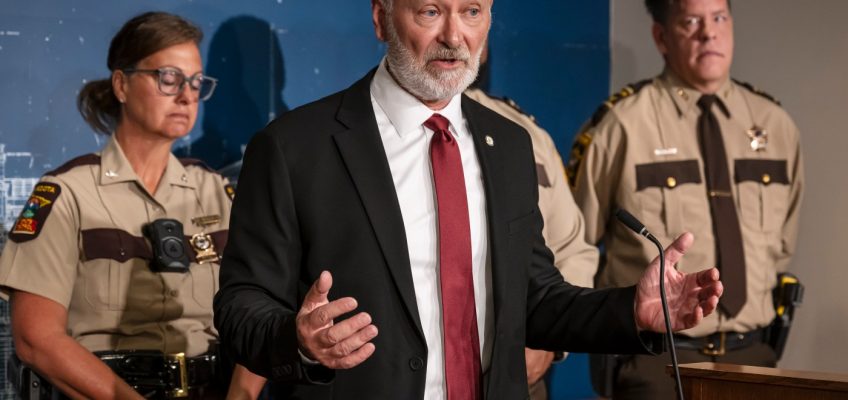Breaking news update: Hawaii and parts of Japan downgraded their tsunami warnings to advisories after a powerful earthquake.
TOKYO — One of the strongest earthquakes ever recorded struck off Russia’s sparsely populated Far East early Wednesday, sending tsunami waves into Japan, Hawaii and the U.S. West Coast. Several people were injured, but none gravely, and no major damage has been reported so far.
Authorities warned the risk from the 8.8 magnitude quake could last for hours, and millions of people potentially in the path of the waves were initially told to move away from the shore or seek high ground. But the danger already appeared to be lessening, with Hawaii and parts of Japan downgrading their warnings.
Residents fled inland as ports flooded on Russia’s Kamchatka peninsula near the quake’s epicenter, while frothy, white waves washed up on the shore in northern Japan. Cars jammed streets and highways in Honolulu, with standstill traffic even in areas away from the sea.
People flocked to evacuation centers in affected areas of Japan, with memories fresh of the 2011 earthquake and tsunami that caused reactor meltdowns at a nuclear power plant. No abnormalities in operations at Japan’s nuclear plants were reported Wednesday.
Russian authorities said several people were injured, but said all were in stable condition, though they gave few details. In Japan, at least one person was injured.
A tsunami height of 3 to 4 meters (10 to 13 feet) was recorded in Kamchatka, 60 centimeters (2 feet) on Japan’s northern island of Hokkaido, while tsunami waves about 2 to 5 feet high reached San Francisco early Wednesday, officials said.
Much of the West Coast, spanning California, Oregon, Washington state, and the Canadian province of British Columbia, were under a tsunami advisory.
Hawaii downgrades to tsunami advisory
Hawaii was still under a tsunami advisory as Wednesday began, but evacuation orders on the Big Island and Oahu, the most populated island, had been lifted.
An advisory means there is the potential for strong currents and dangerous waves, as well as flooding on beaches or in harbors.
“As you return home, still stay off the beach and stay out of the water,” said James Barros, administrator of the Hawaii Emergency Management Agency.
The impact of the tsunami could last for hours or perhaps more than a day, said Dave Snider, tsunami warning coordinator with the National Tsunami Warning Center in Alaska.
“A tsunami is not just one wave,” he said. “It’s a series of powerful waves over a long period of time. Tsunamis cross the ocean at hundreds of miles an hour — as fast as a jet airplane — in deep water. But when they get close to the shore, they slow down and start to pile up. And that’s where that inundation problem becomes a little bit more possible there.”
Hawaii Gov. Josh Green earlier said Black Hawk helicopters were activated and high-water vehicles ready to go in case authorities needed to rescue people.
The Oregon Department of Emergency Management said on Facebook that small tsunami waves were expected along the coast. It urged people to stay away from beaches, harbors and marinas and to remain in a safe location away from the coast until the advisory is lifted.
“This is not a major tsunami, but dangerous currents and strong waves may pose a risk to those near the water,” the department said.
A tsunami of less than 30 centimeters (under 1 foot) was forecast to hit parts of Vancouver Island, British Columbia, and waves of up to 1.4 feet (under 30 centimeters) above tide levels were observed in Alaska’s Aleutian Islands.
Russian regions report limited damage
Russia’s Oceanology Institute said tsunami waves might have been as high as 10 to 15 meters (30 to 50 feet) in some sections of the Kamchatka coast.
In Petropavlovsk-Kamchatsky, Kamchatka’s regional capital, the quake damaged a local kindergarten, which was not in operation at the time because it was being renovated.
Oleg Melnikov, head of the regional health department, said a few people hurt themselves while rushing to leave buildings and a hospital patient was injured while jumping out of a window. Melnikov said that all injured people were stable.
A video released by Russian media outlet showed a team of doctors at a cancer clinic on Kamchatka holding a patient and clutching medical equipment as the quake rocked an operating room, before continuing with surgery after the shaking stopped.
Authorities introduced a state of emergency on the sparsely populated Kurils — which are between Kamchatka and Japan — after the tsunami. They earlier reported that several waves flooded the fishing port of Severo-Kurilsk, the main city on the islands, and cut power supplies to the area. The port’s mayor said no major damage was recorded.
Among the world’s strongest recorded quakes
The quake struck at 8:25 a.m. Japan time with a magnitude of 8.8 magnitude and a depth of about 21 kilometers (13 miles), according to the U.S. Geological Survey.
It was centered about 120 kilometers (75 miles) from the Russian city of Petropavlovsk-Kamchatsky. Multiple aftershocks as strong as 6.9 magnitude followed.
The earthquake appeared to be the strongest recorded since the 9.0 magnitude earthquake off northeastern Japan in March 2011 that caused a massive tsunami that set off meltdowns at a nuclear power plant. Only a few stronger earthquakes have ever been measured around the world.
Japanese nuclear power plants reported no abnormalities. The operator of the Fukushima Daiichi plant damaged by the 2011 tsunami said about 4,000 workers are taking shelter on higher ground at the plant complex while monitoring remotely to ensure safety.
The tsunami alert disrupted transportation in Japan, with ferries, trains and airports in the affected area suspending or delaying some operations.
A tsunami of 60 centimeters (2 feet) was recorded at Hamanaka town in Hokkaido and Kuji port in Iwate, according to the Japan Meteorological Agency. Several areas reported smaller waves including 20 centimeters (8 inches) in Tokyo Bay five hours after the quake.
Japan’s Meteorological Agency partially downgraded its tsunami alert to an advisory in the Pacific coast south of Fukushima, with the alert still in place farther north.
In Japan’s northern coastal town of Matsushima, dozens of residents took refuge at an evacuation center, where water bottles were distributed. One person told NHK she came to the facility without hesitation based on the lesson from the 2011 tsunami.
Japan’s Chief Cabinet Secretary Yoshimasa Hayashi warned evacuees that they may not be able to return home by the end of the day, as the tsunami waves could remain high.
Authorities in the Philippines, Mexico and New Zealand also warned residents to watch for waves and strong currents. People were also urged to stay away from coastlines until any wave surges passed in Fiji, Samoa, Tonga, Federated States of Micronesia and Solomon Islands.
Earlier in July, five powerful quakes — the largest with a magnitude of 7.4 — struck in the sea near Kamchatka. The largest quake was at a depth of 20 kilometers and was 144 kilometers (89 miles) east of the city of Petropavlovsk-Kamchatsky.
Martin Schram: Gabbard’s intel trove brings clarity
UnitedHealth falls short of second quarter expectations and offers weak outlook for 2025
State forecasts loss of $1.4B in Medicaid funding; 140K will lose coverage
Delta pilot arrested on child sex abuse charges after MSP-San Francisco flight
Other voices: Republicans missed a shot at serious Medicaid reform




